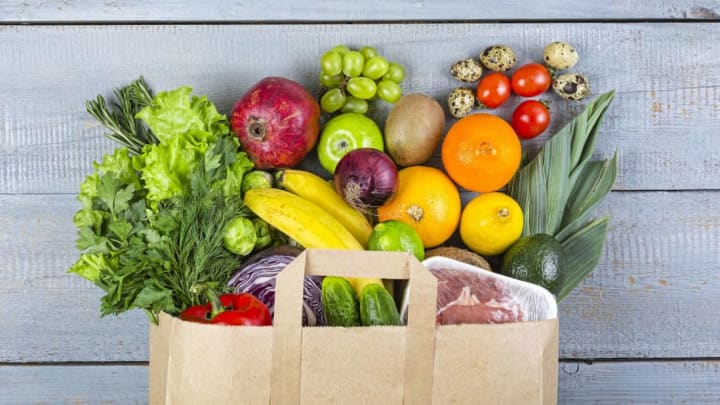With the novel coronavirus majorly disrupting the food service industry, billions of dollars’ worth of food is going to waste as farmers face an overwhelming surplus of perishable items like dairy and fresh vegetables, according to a recent article in The Guardian. Thanks to a scrambled supply chain, nearly half of the food grown in the United States that was previously destined for school cafeterias, restaurants, theme parks, cruise ships, and stadiums is going to waste, with farmers being forced to dump fresh milk and plow vegetables back into the dirt. To better preserve your own supplies—and save some serious cash—check out these 10 ways to reduce food waste at home.
1. Store your food properly.
Correctly storing your food will help it stay fresh longer. If your bread typically molds or goes stale before you have the chance to finish the loaf, keep half of it in the bread box and freeze the other half for later. Store potatoes and tomatoes at room temperature. Don’t stash your eggs in the refrigerator door compartment—this will rattle them around, and may lead to a yolky mess. You can find more helpful food storing tips here.
2. Get well-acquainted with your freezer.

Leftovers, especially meals like soups or stews, are excellent for freezing. But you can freeze individual ingredients, too. Freeze wilted spinach to add to future soups. Frozen berries work well in smoothies, and frozen overripe bananas are perfect for banana bread. Keeping a bag of vegetable scraps in the freezer is a great way to ensure you’ll always have the ingredients for vegetable stock on hand (more on that later). However, there are some foods you should never freeze, and there are certain things you shouldn’t do when defrosting.
3. Learn the best way to freeze different kinds of fruit.
Ripe, fairly unblemished fruit is best for freezing. First, wash the fruit and sort through it for any pieces that are bruised or rotten. Some fruits, like blackberries, raspberries, and plums [PDF], will freeze better with the help of a sugar solution, though cranberries, blueberries, and currants typically do fine on their own. Arrange more delicate berries like strawberries or raspberries in a single layer on a baking sheet (you can also coat them with sugar or a sugar syrup), and then once they’re frozen, put them in a container or a plastic freezer bag. Fruits that tend to brown, like peaches, apple, apricots, and nectarines, can be treated with ascorbic acid (Vitamin C), which you can purchase in powder form in health food stores and some grocery stores.
4. Follow the “first in, first out” rule.
Much like shelves are stocked in grocery stores, use the “first in, first out” method when stocking your refrigerator. After washing your produce and wiping down all other items, put the newer ingredients in the back of the fridge and move the older items to the front so they’ll get used first. A fridge cam can even help you keep track of what’s about to go bad or expire.
5. Keep your fridge uncluttered.

Having to rummage around for an item or not being able to see that bottle of cocktail sauce tucked behind the box o’ wine means more food may go bad before it’s used up. Periodically, take a look at the long-term residents of your fridge, like salad dressings and sauces, to see if they’re still good. If possible, keep them all in one spot to make keeping track of them easier. Also, use square containers for leftovers rather than round ones, as the square shape allows for more storage space. Taking stock of everything you have in both the fridge and the pantry before shopping will also help cut down on clutter and double-buying.
6. Understand expiration dates.
Studies have shown that we throw away more than half of the food we keep in our refrigerators. Misunderstanding food labels is one reason behind the waste. “Sell by” is the date used to inform retailers when an item should be sold or removed from inventory. “Best by” is a suggested date that shoppers should use their products by. Neither means the item is unsafe to eat after that particular date. Even “expires by” isn’t set in stone.
7. Use food scraps to make stock.
Using vegetable scraps like stalks, tops, and peels to make a tasty broth is simple. Sauté them in some butter or oil, then add water and let them simmer for a few hours. Simmer beef bones and chicken carcasses along with the veggies (add water and herbs) to make a delectable homemade broth.
8. Plan your meals in advance.
Knowing what you want to eat for just a few dinners or lunches per week can help you figure out which ingredients you can use across meals and help cut down on spontaneous buying. The Kitchn recommends planning on a Friday, shopping on a Saturday, and then using an hour on Sunday for meal prep.
9. Shop strategically.

Typically, more frequent trips to the grocery store are preferable to buying in bulk when it comes to cutting down on waste, but in these current circumstances, less frequent trips are your safest bet. Therefore, a list is essential—just make sure you're jotting your notes on paper and not touching your phone while shopping. And if there’s any way to order online for delivery or pick-up, keeping an open online shopping cart is the best way to organize and maintain a visual list.
10. Donate items you know you won’t use to your local food bank.
If you have more food on hand than you need, consider donating to a local shelter or food bank. Call ahead and arrange curbside drop off.
